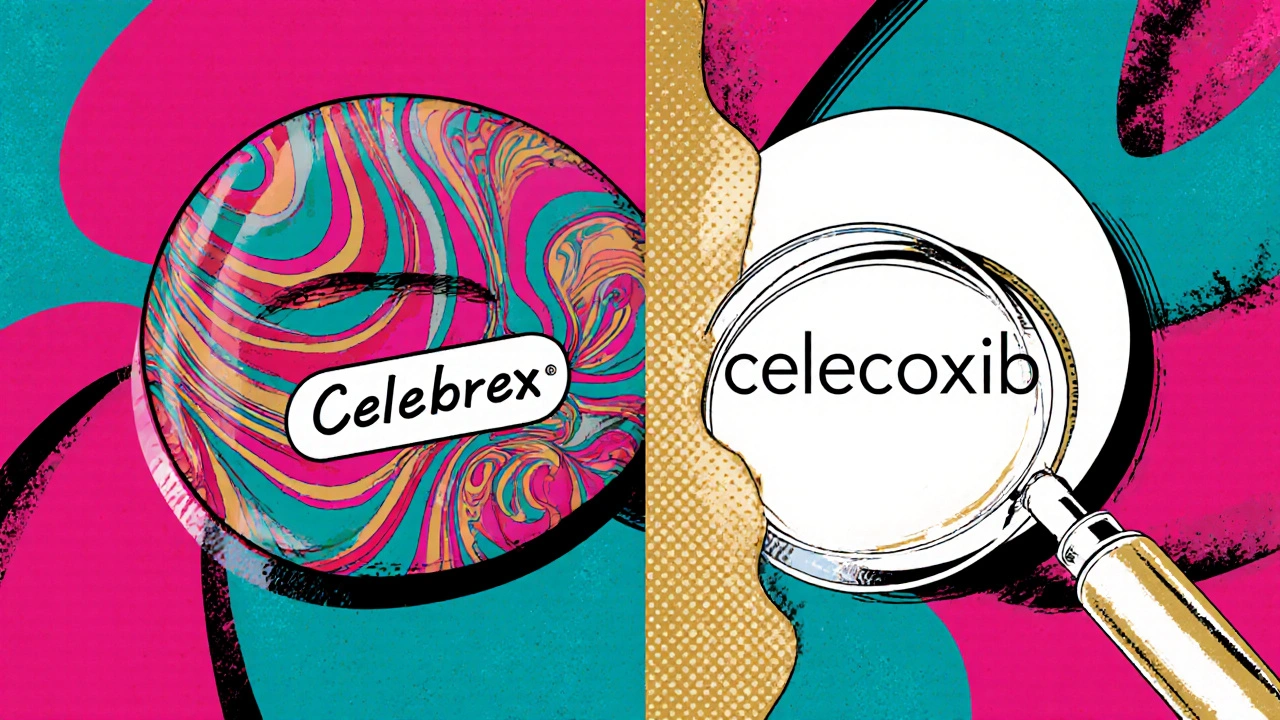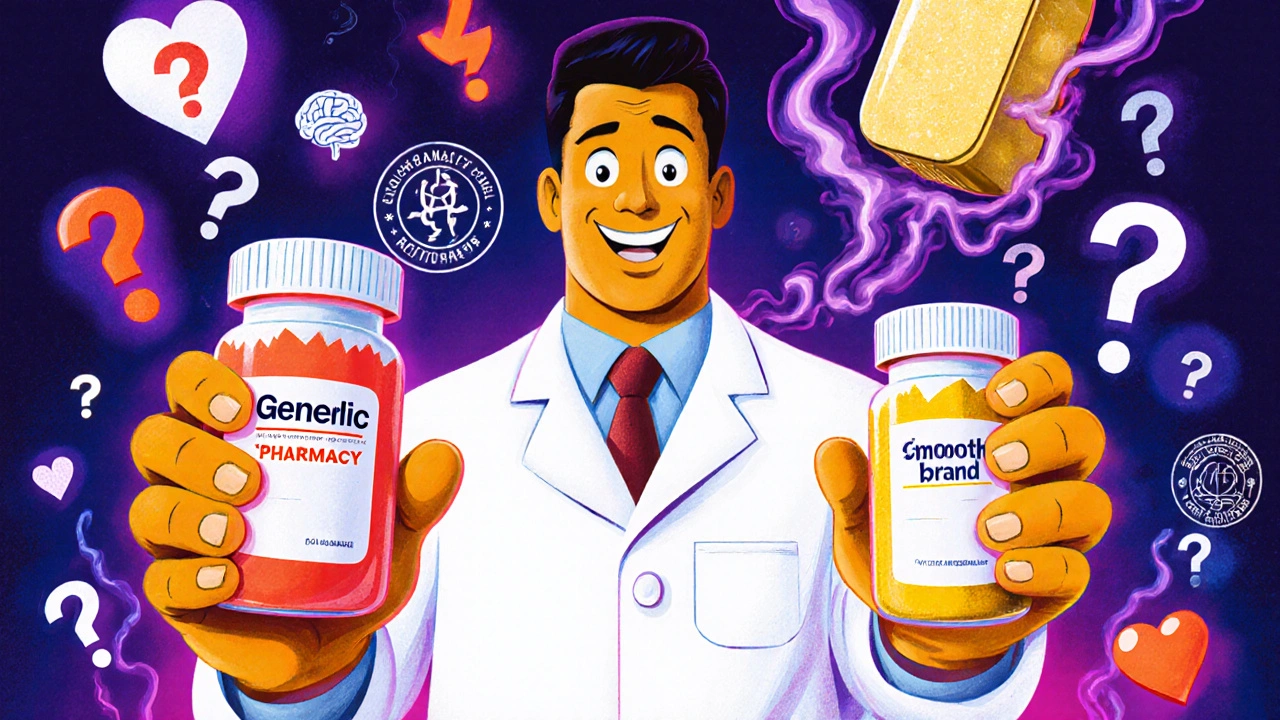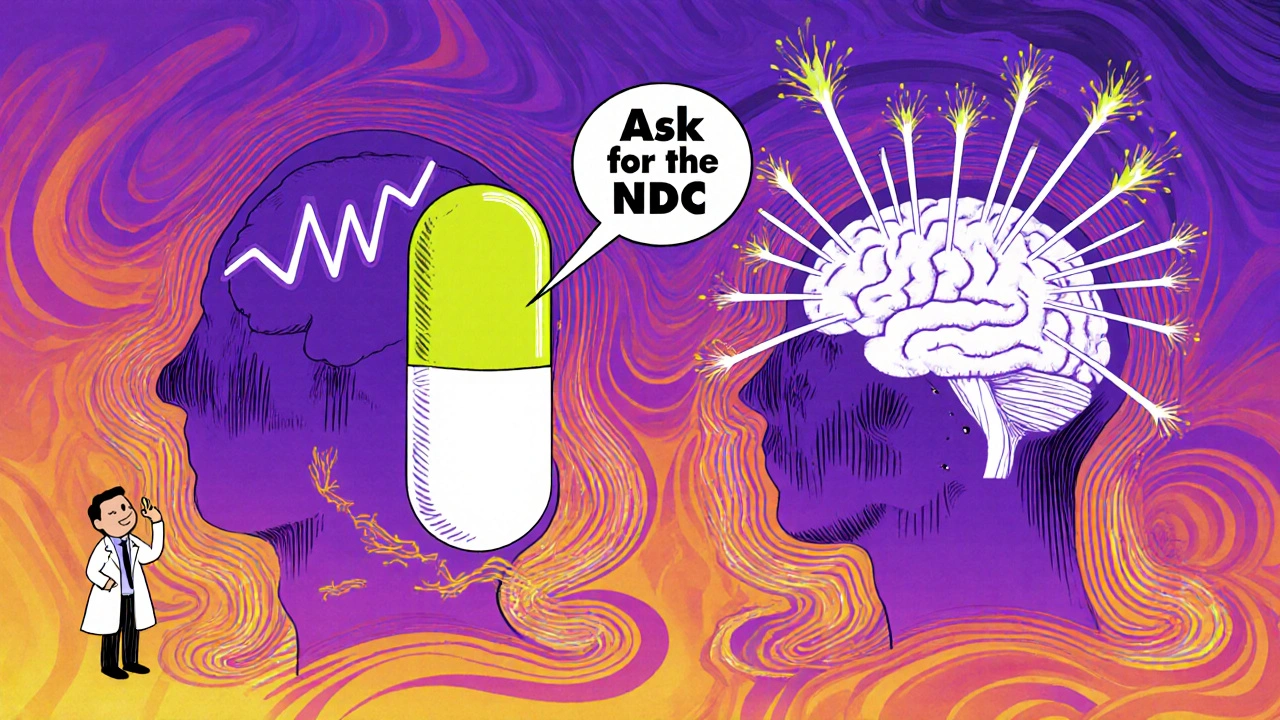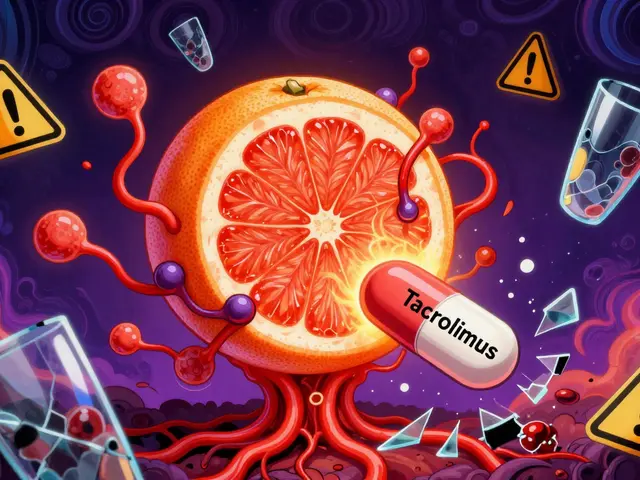
When your doctor says it’s time to switch from your brand-name pill to a cheaper version, you might feel confused. Is the generic just as good? Should you ask for the authorized generic instead? Many people don’t know the difference-and that uncertainty can lead to unnecessary worry, or worse, health setbacks.
Let’s cut through the noise. There are two types of generic drugs you might be offered: the regular generic and the authorized generic. They look similar, cost less than the brand, and have the same active ingredient. But that’s where the similarity ends. The difference isn’t just technical-it can affect how you feel, how often you visit the doctor, and even whether your medication works at all.
What Exactly Is an Authorized Generic?
An authorized generic is the exact same pill as the brand-name drug, just without the brand name on the label. It’s made by the same company, in the same factory, using the same ingredients, down to the last filler and coating. For example, if you take Celebrex for arthritis, the authorized generic is made by Pfizer-the same company that makes Celebrex-using the exact same recipe. The only difference? The box says "celecoxib" instead of "Celebrex."
This isn’t a copy. It’s the original product, repackaged. The FDA defines it clearly: an authorized generic is a brand-name drug sold without the brand name. No testing for bioequivalence is needed because it’s identical. It’s not a different version. It’s the same pill you’ve been taking, just cheaper.
What About Regular Generics?
Regular generics are different. They contain the same active ingredient, but the rest? That’s up to the manufacturer. The fillers, binders, dyes, and coatings can all change. One company might use cornstarch. Another might use lactose. One might make a slow-release tablet with a special coating; another might use a different method entirely.
The FDA requires these generics to be "bioequivalent"-meaning they absorb into your bloodstream within 80% to 125% of the brand-name drug. That’s a 45% range. For most medications, that’s fine. But for drugs where tiny changes matter-like seizure meds, thyroid pills, or blood thinners-that range can mean the difference between control and crisis.
Why Does This Matter When Switching?
Switching from brand to generic isn’t always smooth. Some people notice nothing. Others get headaches, nausea, or worse. A 2023 GoodRx survey of 5,000 patients found that 18.7% had problems after switching to a regular generic. The most common complaints? Feeling like the drug didn’t work as well (33%), new side effects (25%), and stomach issues (42%).
Now compare that to authorized generics: only 6.2% of patients reported issues. Why? Because there’s no change in formulation. Your body isn’t adjusting to new chemicals-it’s getting the same thing it always did.
One patient with epilepsy shared on Reddit: "I switched from brand Lamictal to a regular generic and had two seizures in three weeks. Switched back to the authorized generic-zero problems for 18 months." Another with high blood pressure said: "I switched to a regular generic and my BP improved. Saved $400 a month. No side effects."
Both stories are real. That’s the point: it depends on the drug, the person, and the formulation.
Cost Difference: What You Pay Matters
Authorized generics aren’t cheap. They’re cheaper than the brand, but not by much. You might pay $185 for an authorized generic of Concerta, while the brand costs $210. But a regular generic? $165. That’s a $20 difference per month. Over a year, that’s $240. For people on fixed incomes, that’s not small change.
Regular generics can be 80-85% cheaper than the brand. Authorized generics? Usually only 10-30% cheaper. So you’re trading cost savings for consistency.
Here’s the catch: insurance companies often push regular generics because they’re cheaper. They may not even list the authorized generic on their formulary. If you want the authorized version, you might need to ask your doctor to write "dispense as written" or "no substitution." Otherwise, the pharmacist will automatically give you the cheapest option.

Which Drugs Should You Be Careful With?
Not all medications are created equal. For some, formulation changes can have real consequences:
- Antiepileptics like lamotrigine or phenytoin: Small changes in absorption can trigger seizures.
- Thyroid meds like levothyroxine: Even tiny shifts in hormone levels can cause fatigue, weight gain, or heart issues.
- Immunosuppressants like cyclosporine: Too little and your body rejects the transplant; too much and you risk organ damage.
- Blood thinners like warfarin: A slight change in how it’s absorbed can lead to dangerous clots or bleeding.
The American Academy of Neurology and the American College of Clinical Pharmacy both recommend avoiding automatic substitution for these drugs. Many doctors will specifically prescribe the brand or authorized generic for these cases.
How to Know What You’re Getting
Most patients don’t know what’s in their pill bottle. The label won’t tell you if it’s an authorized generic or a regular one. But you can find out.
Ask your pharmacist for the National Drug Code (NDC) number. It’s a 10-digit code on the label. You can look it up online using the FDA’s database or tools like GoodRx’s Medication Switch Checker. If the NDC matches the brand-name drug’s, you’ve got the authorized generic.
Another trick: check the manufacturer. If the pill says it’s made by Pfizer, Merck, or Johnson & Johnson-the same company that makes the brand-it’s likely an authorized generic. If it’s made by Teva, Mylan, or Sandoz, it’s probably a regular generic.
What Experts Say
Dr. Aaron Kesselheim, a Harvard professor who studies generic drugs, says: "For most medications, regular generics work just fine. But for drugs with narrow therapeutic windows, the exact formulation matters. That’s where authorized generics are valuable."
The FDA says the differences in inactive ingredients don’t affect safety or effectiveness. But real-world data tells a different story. A 2018 study of over 5,000 patients found no major difference in hospitalizations between those who switched to authorized vs. regular generics. But emergency room visits were slightly higher for authorized generics-though not statistically significant. The real difference? Patient experience.
Dr. Lee Vermeulen, former president of the American Pharmacists Association, warns: "Patients report real changes when they switch-even if the science says they shouldn’t. We can’t ignore that."

What Should You Do?
Here’s a simple guide:
- Ask your doctor: "Is there an authorized generic for this drug? Should I use it?" Especially if you’re on a medication with a narrow therapeutic index.
- Check your prescription: If it says "dispense as written," the pharmacist can’t substitute. If it says "substitution permitted," they will give you the cheapest option.
- Ask for the NDC: When you pick up your prescription, ask for the code. Look it up. Know what you’re getting.
- Monitor how you feel: If you switch and notice new side effects, reduced effectiveness, or mood changes, don’t ignore it. Contact your doctor. It might be the formulation.
- Don’t assume all generics are equal: Just because something is cheaper doesn’t mean it’s better for you.
If cost is your main concern, start with the regular generic. But if you’ve had issues before, or you’re on a high-risk medication, ask for the authorized version. It’s not always available, but it’s worth asking.
What’s Changing in 2025?
The FDA is pushing for clearer labeling. Starting in January 2024, authorized generics must be labeled as such on packaging. That’s a big step. It won’t solve everything, but it’ll help patients know what they’re getting.
Medicare Part D plans are now required to tell you if an authorized generic is available for your drug. That means more people will know their options.
And the market is shifting. More brand companies are making authorized generics-63% of top-selling brand drugs now have one. But they’re still only 8% of all generic prescriptions filled. Why? Cost. Most insurers won’t cover them unless you fight for it.
Looking ahead, experts predict authorized generics will grow to 12-15% of the market by 2028-mostly for complex drugs like inhalers, creams, and injectables where formulation matters even more.
Final Thought: It’s Not About Cheap. It’s About Right.
Generic drugs saved the U.S. healthcare system hundreds of billions. They’re essential. But not all generics are the same. The authorized generic isn’t a luxury. It’s a safety net-for people who need consistency, not just savings.
If your medication is critical to your health, don’t settle for "good enough." Ask for the version that’s identical to what you were on. It might cost a little more. But for some, it’s the difference between stability and crisis.
Is an authorized generic the same as the brand-name drug?
Yes. An authorized generic is made by the same company, in the same factory, with the exact same active and inactive ingredients as the brand-name drug. The only difference is the label-it doesn’t have the brand name on it.
Are authorized generics cheaper than regular generics?
No, usually not. Authorized generics are typically 10-30% cheaper than the brand-name drug but often 5-15% more expensive than regular generics. Regular generics are the cheapest option because they’re made by different manufacturers using lower-cost ingredients.
Can pharmacists substitute an authorized generic for a brand-name drug?
No. Pharmacists can only substitute regular generics unless the prescription says "dispense as written" or the prescriber specifically requests the authorized generic. Authorized generics aren’t automatically substitutable because they’re not listed in the FDA’s Orange Book as therapeutically equivalent-they’re identical to the brand, so they’re treated differently.
Which medications are most sensitive to switching generics?
Medications with narrow therapeutic indices are most sensitive. These include antiepileptics (like lamotrigine), thyroid hormones (like levothyroxine), immunosuppressants (like cyclosporine), and blood thinners (like warfarin). Even small changes in how the drug is absorbed can lead to serious side effects or loss of effectiveness.
How do I know if I’m getting an authorized generic?
Ask your pharmacist for the National Drug Code (NDC) on the prescription label. Look it up on the FDA’s database or use tools like GoodRx’s Medication Switch Checker. If the manufacturer matches the brand-name drug’s maker (e.g., Pfizer for Celebrex), you’re likely getting the authorized generic.
Should I always choose the authorized generic?
Not always. For most medications-like statins, blood pressure pills, or antibiotics-regular generics work just fine and save you money. But if you’ve had problems switching before, or you’re on a high-risk drug, the authorized generic offers more consistency and fewer risks. Talk to your doctor about what’s best for you.
What to Do Next
If you’re considering switching or have recently switched and noticed changes, don’t wait. Talk to your pharmacist. Ask about the NDC. Check the manufacturer. If you’re on a critical medication, ask your doctor to write "dispense as written" on your prescription.
And if your insurance won’t cover the authorized generic, ask for a prior authorization. Many plans will approve it if you show clinical need. It’s not guaranteed, but it’s worth trying.
Generic drugs are a win for healthcare. But not all generics are equal. Know the difference. Ask the right questions. And choose the version that works best for your body-not just your wallet.






Erika Puhan
November 9, 2025 AT 18:51Let’s be real-this whole "authorized generic" thing is just pharma’s way of milking the system. The FDA says bioequivalence is fine, so why are we entertaining this luxury-tier placebo? If your body can’t handle a 45% absorption variance, maybe your physiology is the problem, not the pill. The system works because generics save billions. Stop romanticizing brand-name equivalents under a new label. It’s not a safety net-it’s a profit center dressed in medical jargon.
Edward Weaver
November 10, 2025 AT 10:16Look, I don’t care what some Harvard prof says. If you’re on a generic and you’re fine, then stop whining. We’re not in Europe. In America, we don’t pay $200 for a pill when $15 does the same damn thing. If you’re having seizures or your BP spikes, maybe you’re not taking it right. Or maybe you’re one of those people who thinks every change is a conspiracy. The system isn’t broken-it’s optimized. Stop being a medical tourist in your own body.
Lexi Brinkley
November 11, 2025 AT 00:53OMG I switched my levothyroxine to a regular generic last year and I felt like a zombie for 3 months 😫😭 switched back to the authorized one and now I’m literally glowing 🌟 my hair is shiny again, my energy is back, and I didn’t even realize how bad it was until it was gone. y’all need to listen to your bodies, not the insurance reps 💅💊
Kelsey Veg
November 11, 2025 AT 11:52ok but like… the ndc thing? no one knows what that is. i asked my pharmacist and they just handed me the bottle like i was asking for the secret sauce. i had to google it on my phone in the parking lot lmao. also why is it so hard to just say "this is the same pill as celebrex" instead of making us decode barcodes like we’re spies?
Alex Harrison
November 12, 2025 AT 04:59i think the real issue is that we’re treating medicine like a commodity. you wouldn’t swap out the engine in your car with a knockoff part and expect it to run the same. why do we do it with pills? i’ve been on warfarin for 12 years. switched generics once, ended up in the er with a bruise the size of a grapefruit. never again. i pay the extra $15 a month because my life isn’t a cost-cutting experiment. if your insurance won’t cover it, fight them. your health isn’t negotiable.
Jay Wallace
November 13, 2025 AT 10:53Let me just say-this entire discourse is emblematic of a deeper systemic pathology in American healthcare: the commodification of biological integrity. The FDA’s regulatory framework is predicated on statistical equivalence, not clinical fidelity. When you introduce variability in inactive ingredients-especially in drugs with narrow therapeutic indices-you are not merely altering pharmacokinetics; you are introducing stochastic risk into the patient’s homeostatic equilibrium. The authorized generic is not a "premium option"-it is the only ethically defensible choice for high-risk therapeutics. And yet, the insurance-industrial complex continues to prioritize profit over physiological continuity. This is not a market failure-it is a moral failure.
Alyssa Fisher
November 14, 2025 AT 13:12It’s wild how we’ve normalized the idea that "good enough" is fine for our bodies. We wouldn’t accept a knockoff airplane part, but we’ll take a random generic pill because it’s cheaper? The science says most generics are fine-but science doesn’t live in your bloodstream. Your body does. And if you’ve ever felt off after a switch, that’s not "in your head." It’s real. The authorized generic isn’t about luxury. It’s about honoring the fact that human biology isn’t a spreadsheet. We owe it to ourselves to ask for the version that doesn’t force our systems to adapt. It’s not stubbornness. It’s self-respect.
Alyssa Salazar
November 16, 2025 AT 04:07Y’all are missing the point. The authorized generic isn’t just about formulation-it’s about trust. You’re getting the exact same pill your doctor prescribed, from the same company, same batch process, same QA. Regular generics? They’re made by different factories, sometimes overseas, sometimes with different suppliers. Even if it’s "bioequivalent," you’re rolling the dice on fillers that might trigger allergies, GI issues, or weird reactions. I’m not saying everyone needs it-but if you’re on a narrow-window drug, or you’ve had a bad switch before? Don’t be a hero. Ask for the authorized version. And if your pharmacist gives you side-eye? Say "I need the NDC verified." They’ll get it. We’ve got to normalize this demand.
Beth Banham
November 16, 2025 AT 05:26I’ve been on the same antidepressant for 8 years. Switched to a regular generic last year. Felt foggy for months. Didn’t say anything because I didn’t want to be "that person." Then I found out the authorized version existed-and my doctor just wrote "dispense as written." I didn’t even have to fight. Took me two weeks to feel like myself again. I’m not saying everyone needs it. But if you’re quietly struggling after a switch? It’s worth checking. You don’t have to be loud to deserve stability.